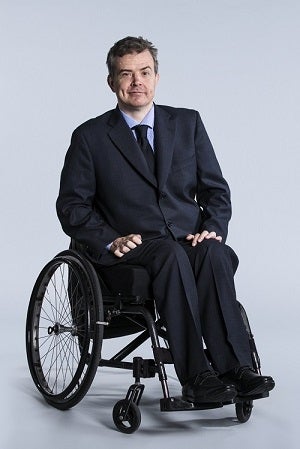Remember disability policy and research deals with the everyday lives

The following speech was an introductory address delivered by Disability Discrimination Commissioner Ben Gauntlett at a policy forum convened by the Centre for Research Excellence in Disability and Health, held in Canberra on July 18, 2019.
Good morning and welcome to today’s policy forum, which has been organised by the Centre for Research Excellence in Disability and Health (CRE-DH).
First, I wish to acknowledge and pay my deep respects to the Traditional Owners of the land – the Ngunnawal people. I pay respect to their Elders; past, present and emerging and acknowledge their continuing connection to this country. I also acknowledge all other Aboriginal and Torres Strait Islander Elders and community members who are here today.
It is an honour to be part of today’s forum. Thank you to Professor Anne Kavanagh of the University of Melbourne, who specialises in health inequalities, and Professor Gwynnyth Llewellyn of the University of Sydney, who has done significant research in the area of family and disability, and their team at the CRE-DH for organising today’s policy forum.
I’m going to discuss the aim of today before relating the importance of good disability research to three areas: first, the importance of disability policy from a human rights perspective; second, the importance of remembering disability policy and research deals with people; and, finally, why policymakers need to promote the National Disability Strategy (and its constituent elements) and the National Disability Agreement.
We, the people of Australia, whether having a disability or not, need to understand that the “culture of silence” regarding disability is over. Diversity and diversity policies should and must include reference to disability.
Decisions concerning disability policy need to be made, though, and made quickly. The policies being dealt with do not necessarily have an effect upon commute time or the attractiveness of a financial investment but they do have an effect upon whether people can get out of bed, attend certain schools, be released from hospital and be viewed as an equal by their friends. Some of these issues have lifelong implications – government and researchers need to remember that possibility.
AIM OF TODAY
Creating strong links between disability policy and research is the key aim of today. There will be an interaction between policymakers and researchers throughout the day where the value of focusing on disability from a social determinants of health framework and the importance of the CRE-DH will be discussed.
IMPORTANCE OF RESEARCH – A HUMAN RIGHTS PERSPECTIVE
Research is particularly important to my work as the Disability Discrimination Commissioner and the work of the Australian Human Rights Commission (Commission), more broadly.
At the Commission, research helps provide a thorough, well-rounded understanding of the status of disability rights (which are a form of human right) in Australia – including the local political, social, and cultural context in which human rights may be contravened. Research also helps us identity key actors and develop strategies to influence these actors to improve the human rights situation for people with disability and the entire community. An example of this is the concept of “universal design”, which benefits everyone.
The role of the Disability Discrimination Commissioner is not only to advance disability rights and the welfare of people with disabilities but to prevent discrimination.
The Story So Far
It has been 10 years since Australia ratified the UN Convention on the Rights of Persons with Disabilities (CRPD).
The CRPD embodies a paradigm shift in the understanding of disability – from a medical or charity model of disability that focuses on personal impairments as the cause of social exclusion, to a human rights model of disability, which sees disability as a social construct arising from a dynamic interaction between impairment and social barriers.
There is no doubt that the ratification of the CRPD has inspired and encouraged significant reform in Australia – the National Disability Insurance Scheme (NDIS), which is a subset of the National Disability Strategy, is the most prominent example. But perhaps, more importantly, it did begin to change the framing or the lens through which we consider disability policy. The focus did become removing the structural and systemic barriers to full and effective participation in Australia; on creating fully inclusive societies.
This theme is clear in the work and research themes of the CRE-DH, particularly in its work to better understand the social determinants of health.
As I’m sure I don’t need to tell anyone in this room, it is a busy time for disability policy. From the new Royal Commission, to a new iteration of the National Disability Strategy – and potentially the National Disability Agreement – to continued work in respect of the NDIS. However, at its core disability policy has everyday implications for all Australians.
DISABILITY POLICY AND RESEARCH DEALS WITH PEOPLE
I’m a quadriplegic as a result of a spinal cord injury aged 16 playing rugby union. The game was a replay of a match my school had won unexpectedly when some key players from the other school had other commitments. It was a Monday night and I had the choice to play rugby or athletics. I chose rugby. The referee didn’t turn up but we played anyway.
I didn’t though really appreciate the implications of disability policy until I went to the University of Oxford eight years later on a Rhodes Scholarship. Care, access to premises and accommodation all needed to be arranged. I had nearly not applied for the scholarship because I thought the selection committee would think it was too difficult.
But I did.
In the United Kingdom, it was relatively common for carers not to show up or carers to show up with little or no training. I remember the absolute fear of raising my concerns and wondering if I would have no support. I recall spending extended periods in bed because no one showed up.
I also recall wondering if raising access concerns would see me classified as a “troublemaker” or “problematic”.
Fortunately through luck and people being very kind I survived but, at the same time, I did not flourish. I avoided some very dangerous situations by chance. My expectations of the career and quality of life I would have were very low.
The “charity” or “impairment” model of disability ignores these issues relating to self-esteem and interaction with society.
Thankfully, the CRPD reflects an understanding that focusing on impairment creates a ceiling on people with disability. The treaty also acknowledges the importance of “awareness raising” and “data collection”.
In the area of health, a social model of disability translates to focusing on removing all societal structures, barriers and practices that limit the full and equal enjoyment of the right to the highest attainable standard of health by all people with disability.
It also brings to the fore the need to focus on the social and environmental detriments of health. Poverty, discrimination, intersectionality, violence and social exclusion, as well as barriers in accessing health care, contribute to Australians with disability having poorer health outcomes.
THE NATIONAL DISABILITY STRATEGY AND NATIONAL DISABILITY AGREEMENT
Looking to the future, how do we work to ensure the vision of the CRPD is fully realised in Australia? There are opportunities on the horizon – the next iteration of the National Disability Strategy, the Royal Commission and the NDIS.
But how do we make the most of these opportunities for the 4.5 million Australians who have a disability? And create new ones? What kind of research and evidence do we need, in these policy contexts, to create meaningful change over the coming decade in Australia? How do we do so in a timely manner where we understand a person denied inclusive education or housing or the opportunity to work may struggle to avail themselves of future opportunities? Is there a tangible reason the National Construction Code cannot be amended to ensure people with disabilities can readily live in private housing, or advertising cannot be conducted to challenge stereotypes to improve employment outcomes?
The CRPD reflects a new framing for disability. But this framing of course was not automatically superimposed onto Australia’s domestic laws and policies. Rather, ongoing efforts are needed to ensure that the values of the CRPD are internalised and are embedded as the cornerstone of change.
The Disability Discrimination Act 1992 (Cth) clearly focuses on impairment (and needs reform) but the critical issue is the National Disability Strategy of which the NDIS and the Disability Discrimination Act and associated legislation) are an aspect. The NDIS is predicated on economic assumptions regarding the knowledge of participants and the willingness and abilities of providers to provide appropriate assistance. But, without the National Disability Strategy being implemented expeditiously, it is like an accessible house reflecting principles of universal design surrounded by an inaccessible environment.
For the National Disability Strategy to work we need the National Disability Agreement to be updated in a meaningful way.
National Disability Strategy
The late Cambridge physicist Professor Stephen Hawking said "[t]he greatest enemy of knowledge is not ignorance, it is the illusion of knowledge". The National Disability Strategy is Australia’s main vehicle for implementing the CRPD. The CRPD (and, in particular, Articles 31 and 33) understands the importance of data and its use in a variety of contexts.
The next National Disability Strategy should incorporate a national independent performance reporting framework across all levels of government. This should be complimented by robust data collection, research and evaluation activities, which includes the academy (and entities such as the CRE-DH) and people with disabilities. These activities can then inform future policy directions and actions. We must not be attracted by the illusion of knowledge or frightened by healthy debate on policy choices.
Effective ongoing monitoring of the National Disability Strategy through research and data collection is essential to drive reform and implementation of the CRPD. We cannot assume we know the outcome of policies and their effect. Policies need to adapt and evolve to changes in circumstances.
Today’s conference advances the implementation of the CRPD and is to be commended.
However, we need to remember any policy or research deals with the everyday lives of people – change must occur quickly.
Thank you.

